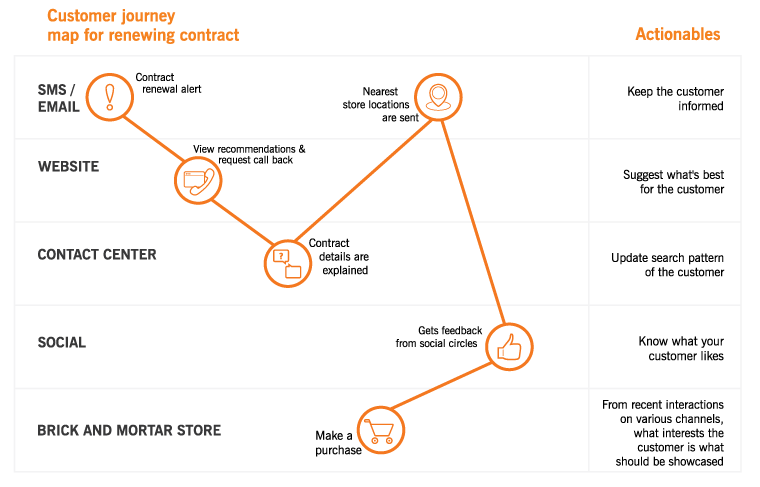Defining the Omni-Channel Experience
Your customers are everywhere: in brick-and-mortar stores, sitting at desktop computers at home, in the workplace, or on the go with smartphones and tablets. They connect to your business through personal contact, web sites, and social media. To meet your customer expectations and provide them a superior experience you need a cohesive approach to interact and allow them to communicate easily with you. This is the omni-channel experience that thrives in the digital age and with technology-savvy consumers.
When businesses think about Omni-channel they think about the problem from their point of view – to communicate their message to the customer consistently through multiple channels. Some fail to realize that Omni-channel is not about them, it is about the customer: what they wish to do, which way they want to do it, and how they wish to consume the information and the services the company offers.
When you think from the customers’ perspective, not the business point of view, about how customers wish to drive their interactions, how they want to decide the scope, extent, and content of what they wish to see from you, you quickly come to realize that Omni-channel is not just a mechanism to communicate per transaction with them, but rather an opportunity to hold a conversation which helps offer a memorable experience that delivers above and beyond what they wish to accomplish.
Holding a conversation with the customer requires clear identification of the two parties involved – the customer, who is not a store customer vs online vs telephone customer but ONE customer interacting across channels, and the business, who is not the contact center agent, the app/digital website or physical store agent but ALL of them. This implies that understanding who the customers are and what you know about them and what the customers are looking for based on their interactions is paramount. It further implies that acting consistently, cohesively, and coordinately across your customer facing teams is essential.
That’s not all, though. The content of the conversation is the exchange of ideas built upon each other to create value for the participants. It requires you to connect the previous interaction to the next one. True Omni-channel reflects a conversation starting in one channel not only continues in the next, but adds value by moving the dialogue forward.
When I recently faced a service problem with a provider recently, I tried to resolve it using self-service. When that did not work properly, due to confusing and limited options to find solutions or reporting mechanisms, I tried the contact center support…three times. Each time, I was met with by a support agent who, though having been authenticated by the IVR, and re-authenticated by themselves, were unable to refer to my previous conversation and required me to explain the entire issue again, predictably proposed the same solution that was tried in the past, and failed to meet my expectations which could have been done by simply ensuring when exactly an action had been initiated to verify if things had gotten better.
Needless to say, I churned out. The maligned icing on the good-bye cake was the Customer Retention Team calling me to offer discount on the service without even checking that the service itself was the problem.
So how can we get it Right?
Act on insights from big data for Omni-Channel Experience
Omni-channel communication should be seen as an evolutionary process. While many businesses have for years participated in multiple markets that include physical storefronts, call centers, catalogs, and more recently online channels, these operations have existed substantially as functional, organizational, and technical silos within the business. They have operated in parallel, not in concert. As a result, from a customer viewpoint, they are seen as independent entities, frequently learning this the hard way when crossing channels during their journey and becoming disenchanted when they find that service providers send targeted cross-sell messages without actually making subscription to multiple services easy for existing customers. For instance, despite being a loyal customer for mobile services, the onboarding process for signing up to DTH services from the same service provider is tedious with long application forms seeking details of mobile number, address and other details that they already know or after having a detailed conversation about their interest in a specific product, the recommendations by customer care representative of upgrading to the new plan being different to those of the person at the physical store. It is such inconsistencies that frustrate the customer that your business may not get another chance to repair.
Omni-channel is not a system or even a set of systems. One customer experience executive from a large Western European operator told “This is about so much more than just a software platform or set of technologies”.
Business agility that drives the omni-channel customer experience mandates leveraging legacy and new-age systems to form a cohesive ecosystem that enables appropriate action on insights presented by big data. The actions should be driven by a consolidated Customer Business Process which results in a platform where disparate back-end systems combine to provide consistent capabilities, across channels, that can help organizations provide an effective omni-channel experience.
The Omni-Channel Experience is all About the Customer
Personalization is the key to ensure a successful Omni-channel experience. Customers must be presented with a preselection of the information or products they have an interest in. For example, customers whose mobile contracts are due for renewal should be presented with simple selection of the services needed to facilitate a seamless journey personalized for their needs. This facilitates the customer decision, promotes customer satisfaction, speeds business revenue, and elevates customer loyalty. It’s a win-win for both the customer and the business.
This chart illustrates how the customer journey can be significantly enhanced to deliver a consistent omni-channel experience.

The cornerstone of Omni-channel is enabling of customer engagement across any channel to ensure a seamless hand-off between them. Importantly though, it must be consistent with each related channel – especially digital channels. Every channel will not be suitable to offer precisely the same experience: a kiosk, computer, tablet, or smartphone will have varying requirements. It’s the responsibility of the service provider to present the appropriate content – presented in the right way – for each particular device and context.
Ratko Popovski, VP Solution Architecture, Liberty Global and Member of the Executive Committee, TM Forum, commented: “Omni-channel is a business capability. It’s not about buying as set of tools and getting omni-channel. It’s rather the know-how and ability to realize exceptional customer journeys using the tools”.
Done well, omni-channel is a key enabler of customer centricity, broadly supporting companies’ need to identify, engage, inform, and support targeted customers (such as high-value customers) across the brand and throughout the customer lifecycle. Of highest importance is the removal of barriers between channels, which allows the customer to focus on the brand and not the channels utilized. Business and customers alike will benefit in multiple ways:
- Customers will be happier through an efficient seamless journey
- Business operations will become more efficient
- Opportunities for cross-sell and up-sell to customers will be enhanced
In10s Technologies empowers business with the agility to act on insights from big data to gain a competitive edge in working with customers. We enable business to react quickly to changing customer expectations and demands.
Contact In10s Technologies today to discover how we can help your business develop a cohesive omni-channel experience to enhance customer acquisition, retention, insight, and engagement.
[subscribe-author-button][/subscribe-author-button] 0